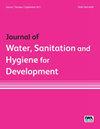黑蝇处理粪便的工艺性能评价
IF 1.4
4区 环境科学与生态学
Q3 WATER RESOURCES
Journal of Water Sanitation and Hygiene for Development
Pub Date : 2023-05-18
DOI:10.2166/washdev.2023.010
引用次数: 1
摘要
粪便的可持续管理是一项普遍存在的全球性挑战。在这项研究中,我们评估了黑兵蝇(BSF)在用厨余垃圾(FM:KW)共处理粪便时的工艺性能。采用5日龄BSF幼虫5 g,每处理1 kg左右,每隔3 d随机选取100只幼虫,监测整个处理过程中幼虫的增重情况。监测幼虫日至50%化蛹量、平均蛹产量、废物减减率(WR)、生物转化率(BRs)和饲料转化率(fcr)。研究结果表明,以1:1配比的基质在较短的发育时间内获得较高的WR、废物减量指数(WRI)、BR、FCR和总蛹前产量的最佳指标。此外,我们采用改进的Gompertz模型对BSF幼虫增重进行建模,以评估动物饲料加工中最佳生物量转化的最短时间。BSF幼虫呈s型生长曲线,改进的Gompertz模型能较好地量化BSF幼虫的生长性能。在未来,我们的方法将为现场卫生设施粪便的有效处理和增值,管理有机城市废物以及提供替代动物饲料和生物肥料铺平道路。本文章由计算机程序翻译,如有差异,请以英文原文为准。
Process performance evaluation of faecal matter treatment via black soldier fly
Sustainable management of faecal matter is a prevailing global challenge. In this study, we assessed black soldier fly (BSF) process performance during co-treatment of faecal matter using kitchen waste (FM:KW) to formulate five feeding substrates. About 1 kg of each feed substrate was treated utilizing 5 g of 5-day-old BSF larvae after which 100 larvae were randomly picked at 3-day intervals from each treatment to monitor the larval weight gain across the treatment process. Larval days to 50% pupation, mean pupal yield, waste reduction rate (WR), bioconversion rates (BRs), and feed conversion rates (FCRs) were monitored for the process performance. Study results showed that the substrate 1:1 attained the best measures of high WR, waste reduction index (WRI), BR, FCR, and overall pre-pupal yield within a shorter development time. Further, we modelled the BSF larval weight gain using the modified Gompertz model to assess the least time for optimal biomass conversion for animal feed processing. The BSF larvae exhibited an S-shaped growth curve and the modified Gompertz model adequately quantified the BSF larval growth performance. In the future, our methodology will pave the way for effective treatment and valorization of faecal matter from onsite sanitation facilities, manage organic municipal wastes and provide alternative animal feed and bio-fertilizer.
求助全文
通过发布文献求助,成功后即可免费获取论文全文。
去求助
来源期刊

Journal of Water Sanitation and Hygiene for Development
WATER RESOURCES-
CiteScore
3.10
自引率
11.80%
发文量
58
审稿时长
16 weeks
期刊介绍:
The Journal of Water, Sanitation and Hygiene for Development is a peer-reviewed journal devoted to the dissemination of high-quality information on the science, policy and practice of drinking-water supply, sanitation and hygiene at local, national and international levels.
 求助内容:
求助内容: 应助结果提醒方式:
应助结果提醒方式:


